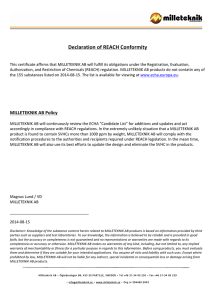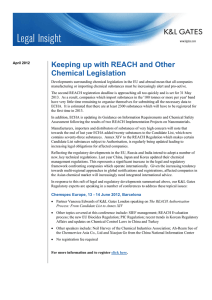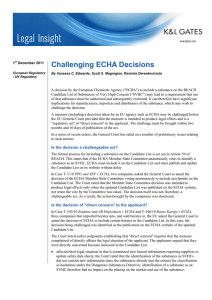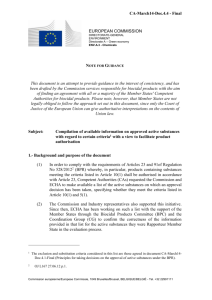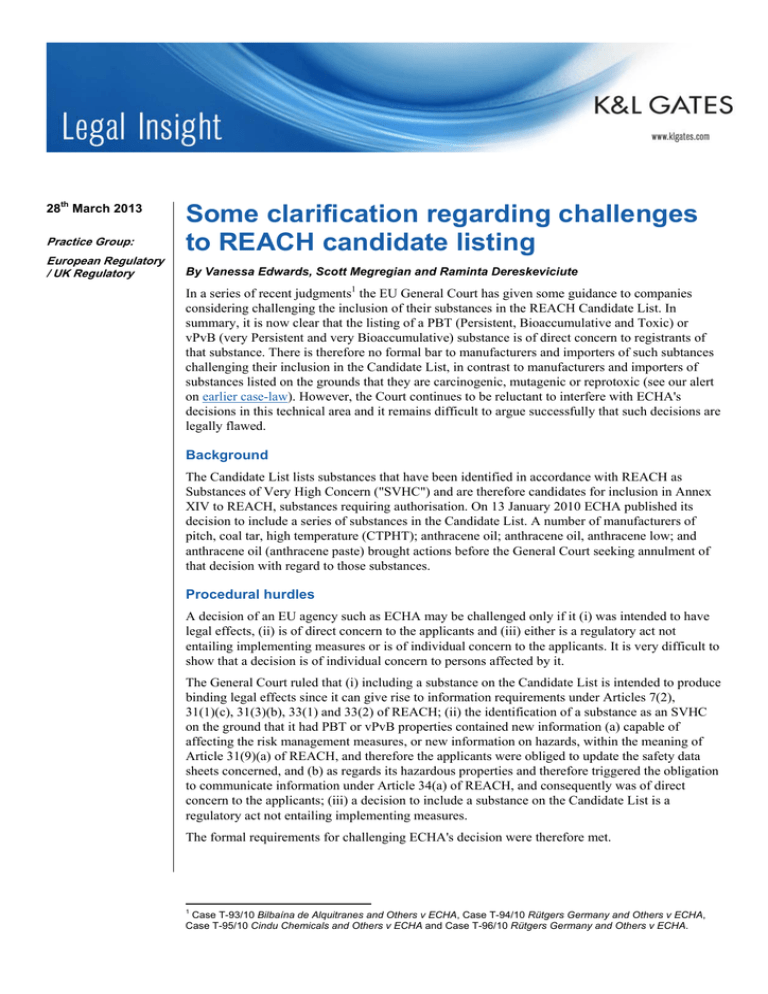
28th March 2013
Practice Group:
European Regulatory
/ UK Regulatory
Some clarification regarding challenges
to REACH candidate listing
By Vanessa Edwards, Scott Megregian and Raminta Dereskeviciute
In a series of recent judgments1 the EU General Court has given some guidance to companies
considering challenging the inclusion of their substances in the REACH Candidate List. In
summary, it is now clear that the listing of a PBT (Persistent, Bioaccumulative and Toxic) or
vPvB (very Persistent and very Bioaccumulative) substance is of direct concern to registrants of
that substance. There is therefore no formal bar to manufacturers and importers of such subtances
challenging their inclusion in the Candidate List, in contrast to manufacturers and importers of
substances listed on the grounds that they are carcinogenic, mutagenic or reprotoxic (see our alert
on earlier case-law). However, the Court continues to be reluctant to interfere with ECHA's
decisions in this technical area and it remains difficult to argue successfully that such decisions are
legally flawed.
Background
The Candidate List lists substances that have been identified in accordance with REACH as
Substances of Very High Concern ("SVHC") and are therefore candidates for inclusion in Annex
XIV to REACH, substances requiring authorisation. On 13 January 2010 ECHA published its
decision to include a series of substances in the Candidate List. A number of manufacturers of
pitch, coal tar, high temperature (CTPHT); anthracene oil; anthracene oil, anthracene low; and
anthracene oil (anthracene paste) brought actions before the General Court seeking annulment of
that decision with regard to those substances.
Procedural hurdles
A decision of an EU agency such as ECHA may be challenged only if it (i) was intended to have
legal effects, (ii) is of direct concern to the applicants and (iii) either is a regulatory act not
entailing implementing measures or is of individual concern to the applicants. It is very difficult to
show that a decision is of individual concern to persons affected by it.
The General Court ruled that (i) including a substance on the Candidate List is intended to produce
binding legal effects since it can give rise to information requirements under Articles 7(2),
31(1)(c), 31(3)(b), 33(1) and 33(2) of REACH; (ii) the identification of a substance as an SVHC
on the ground that it had PBT or vPvB properties contained new information (a) capable of
affecting the risk management measures, or new information on hazards, within the meaning of
Article 31(9)(a) of REACH, and therefore the applicants were obliged to update the safety data
sheets concerned, and (b) as regards its hazardous properties and therefore triggered the obligation
to communicate information under Article 34(a) of REACH, and consequently was of direct
concern to the applicants; (iii) a decision to include a substance on the Candidate List is a
regulatory act not entailing implementing measures.
The formal requirements for challenging ECHA's decision were therefore met.
1
Case T-93/10 Bilbaína de Alquitranes and Others v ECHA, Case T-94/10 Rütgers Germany and Others v ECHA,
Case T-95/10 Cindu Chemicals and Others v ECHA and Case T-96/10 Rütgers Germany and Others v ECHA.
Some clarification regarding challenges to REACH
candidate listing
Legal arguments
The applicants put forward a number of arguments as to why the decision was contrary to EU law
and should be annulled. All arguments were rejected by the General Court. A very brief summary
follows.
Principle of equal treatment
The applicants argued that identification of each substance as an SVHC breached the principle of
equal treatment since the listed substance was comparable, in terms of its content of chemical
substances and of competition on the market, to other substances with similar constituents which
had not been identified as SVHCs. The Court ruled that under Article 59 of REACH it was for the
Commission or the Member State which had prepared the Annex XV dossier to decide whether a
substance met the criteria for being identified as an SVHC. Since ECHA had no discretion as
regards the choice of the substance to be identified, and since no other Annex XV dossiers had
been prepared for the allegedly comparable substances, in identifying each listed substance and
not identifying allegedly comparable substances as an SVHC ECHA did not breach the principle
of equal treatment.
Principle of proportionality
The applicants argued that the decision did not respect the principle of proportionality on a
number of grounds. That principle requires that measures adopted by EU institutions do not
exceed the limits of what is appropriate and necessary in order to attain the objectives legitimately
pursued by the legislation in question; when there is a choice between several appropriate
measures recourse must be had to the least onerous, and the disadvantages caused must not be
disproportionate to the aims pursued.
The Court started by stressing that ECHA has a broad discretion in a sphere which entails
political, economic and social choices on its part, and in which it is called upon to undertake
complex assessments. A measure adopted in that sphere will be unlawful only if it is manifestly
inappropriate having regard to the objective of the legislation in question.
First, the applicants had argued that the decision was not suitable for the attainment of the
objective of REACH, which was to ensure a high level of protection of human health and the
environment, since the substances which could be used to replace each listed substance also had
PBT or vPvB properties. The Court ruled that identification of a substance as being of very high
concern improved information for the public and professionals as to the risks and dangers incurred
and, consequently, was a means of enhancing that protection.
Second, the applicants had argued that the contested decision exceeded the limits of what was
necessary to achieve those objectives, given that the application of risk management measures on
the basis of the chemical safety assessment in the registration dossier or the presentation of an
Annex XV dossier for restrictions would also meet those objectives but would be less onerous.
The Court ruled that the objective of the authorisation procedure, of which candidate listing was
part, was, inter alia, progressively to replace SVHCs with other appropriate and economically or
technically viable substances or technologies. Consequently, risk management measures were not
appropriate for the achievement of those objectives. Even if restriction measures were also
appropriate for the achievement of such objectives, they were not, as such, less onerous measures
than candidate listing.
The following, more technical, arguments were also dismissed by the Court, illustrating the
difficulties of successfully challenging ECHA's decision to include a substance on the Candidate
List:
2
Some clarification regarding challenges to REACH
candidate listing
• The Annex XV dossier for each substance did not observe the requirements set out in Article
59(2) and (3) and in Annexes XIII and XV to REACH because it was not based on an
assessment of the substance itself but on an assessment of the properties of its constituents.
• The rule that a substance may be identified as having PBT or vPvB properties provided that it
contains a constituent which has PBT or vPvB properties and is present in a concentration of
0.1% or more is not provided for in Annex XIII to REACH and therefore has no legal basis.
• The assessment of the constituents of a substance is not a sufficient basis for its identification
as having PBT or vPvB properties since those constituents have not been individually
identified as having PBT or vPvB properties in a separate ECHA decision based on a thorough
assessment for that purpose.
• The rule of the 0.1% threshold was not respected given that the listed substance contained the
only constituent officially identified as a PBT substance, at levels of less than 0.1%.
• Contrary to REACH, some Annex XV dossiers did not include information on alternative
substances even though Germany (which submitted the dossier) had been informed by the
applicants of the existence of such substances. Without that irregularity and if the fact that the
alternative substances also contained PBT constituents had been known, the decision might not
have been adopted and a different procedure might have been triggered.
• ECHA had no authority to amend the proposal made by Germany concerning the inclusion of
certain substances in the Candidate List, which was based solely on the fact that that substance
had PBT and vPvB properties. Following that amendment, the substance concerned was
identified as an SVHC on the basis not only of its PBT and vPvB properties as alleged, but
also of its carcinogenic properties.
• The assessment of the constituents of the substance at issue did not furnish a sufficient basis to
identify it as having PBT or vPvB properties since those constituents were not individually
identified as having PBT or vPvB properties.
Time-limits for Candidate List challenges
Even more recently, an Advocate General (AG) at the Court of Justice (the senior EU court) has
delivered his Opinion in appeals against two judgments of the General Court2 in which that Court
ruled that (i) the date of publication of the updated Candidate List on the ECHA website was the
start of the period within which challenges must be brought and (ii) the provision in its Rules of
Procedure that the time-limit started from the end of the 14th day following publication did not
apply to acts published not in the Official Journal of the European Union but exclusively on the
Internet.
The AG considers that the Court of Justice should rule that:
• The decision of the Executive Director of ECHA to include a substance on the Candidate List
is the final act bringing to an end the procedure laid down in Article 59 of REACH and
accordingly starts time running from the date of publication of that decision.
• The 14-day provision applies to the calculation of the time-limits for bringing proceedings
against any published acts of EU institutions, bodies, offices and agencies, whatever method of
publication is used.
The AG's Opinion is not binding on the judges of the Court of Justice but in the majority of cases
the judgment comes to the same conclusion. The judgments in these cases should be delivered in
the course of this year.
2
Cases C-625/11 and C-626/11 Polyelectrolyte Producers Group and SNF v ECHA; see our alert on earlier case-law
for a summary of the judgments of the General Court appealed against.
3
Some clarification regarding challenges to REACH
candidate listing
Authors:
Vanessa Edwards
vanessa.edwards@klgates.com
+44.20.7360.8293
Scott Megregian
scott.megregian@klgates.com
+44.20.7360.8110
Raminta Dereskeviciute
raminta.dereskeviciute@klgates.com
+44.20.7360.8264
Anchorage Austin Beijing Berlin Boston Brisbane Brussels Charleston Charlotte Chicago Dallas Doha Dubai Fort Worth Frankfurt
Harrisburg Hong Kong Houston London Los Angeles Melbourne Miami Milan Moscow Newark New York Orange County Palo Alto
Paris Perth Pittsburgh Portland Raleigh Research Triangle Park San Diego San Francisco São Paulo Seattle Seoul Shanghai
Singapore Spokane Sydney Taipei Tokyo Warsaw Washington, D.C.
K&L Gates practices out of 47 fully integrated offices located in the United States, Asia, Australia, Europe, the
Middle East and South America and represents leading global corporations, growth and middle-market
companies, capital markets participants and entrepreneurs in every major industry group as well as public
sector entities, educational institutions, philanthropic organizations and individuals. For more information
about K&L Gates or its locations, practices and registrations, visit www.klgates.com.
This publication is for informational purposes and does not contain or convey legal advice. The information herein should not be used or relied upon
in regard to any particular facts or circumstances without first consulting a lawyer.
©2013 K&L Gates LLP. All Rights Reserved.
4

